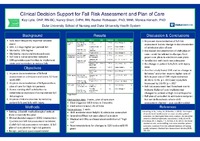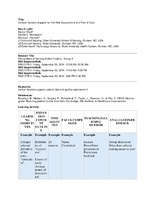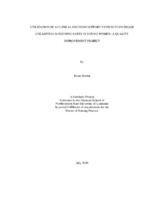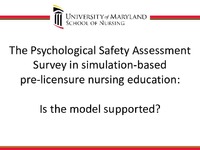| dc.contributor.author | Lytle, Kay S. | en |
| dc.contributor.author | Richesson, Rachel L. | en |
| dc.contributor.author | Short, Nancy | en |
| dc.contributor.author | Horvath, Monica L. | en |
| dc.date.accessioned | 2015-01-15T13:36:41Z | |
| dc.date.available | 2015-01-15T13:36:41Z | |
| dc.date.issued | 2015-01-15 | |
| dc.identifier | LEAD14PST113 | en |
| dc.identifier.uri | http://hdl.handle.net/10755/338385 | |
| dc.description | <p>Leadership Summit 2014 Theme: Personal. Professional. Global. Held at the Indianapolis Marriott Downtown, Indianapolis, Indiana, USA.</p> | en |
| dc.description.abstract | <p>Session presented on Friday, September 26, 2014:</p>
<p>Patient falls are the most frequently reported adverse event for hospitals. Employing clinical decision support (CDS) tools in the electronic health record can be a key strategy to reduce patient falls. This quality-improvement project involved 16 adult inpatient units at Duke University Hospital and used CDS as an intervention to document fall risk assessments and, for patients at high risk, fall prevention plans of care. Goals of the project included 1) improving documentation of fall risk assessments upon patient admission and every 12-hour nursing work shift, 2) improving documentation of fall prevention plans of care for high risk patients, 3) assessing nursing staff satisfaction to determine acceptance of the computerized fall risk program, and 4) improving clinical outcomes by reducing patient falls and patient falls with injury. The CDS tools for fall prevention included three features: 1) an admission documentation incomplete fall risk assessment indicator, 2) a shift documentation incomplete fall risk assessment indicator, and 3) a rules-based alert for patients at high risk for falls and not on a fall prevention plan of care. This fall-prevention related CDS was implemented as part of the Epic Systems EHR in June 2013. Pre and post data were compared using quarterly audits, retrospective chart review, safety reports, alert action data, falls and falls-with-injury rates, and focus groups. At the start of the project, one medical unit and one surgical unit were performing below the target 90% documentation compliance rate for fall assessments and plans of care; these two units were selected for retrospective chart review relative to documentation of the fall risk assessments and fall prevention plans of care. These two units were also selected for review of alert action data in the post-CDS period and focus groups to evaluate nursing staff satisfaction. Documentation of fall risk assessments on the 16 units improved significantly according to quarterly audit data (P = .05), while documentation of the plans of care did not. Retrospective chart review on two units indicated improvement for admission fall risk assessment (P = .05) and a decrease in the documentation of the shift plan of care (P = .01); one unit had a statistically significant decrease in documentation of plans of care on admission (P = .00). Examination of safety reports for patients who fell showed all patients pre and post CDS had a fall risk assessment documented. The care plan alert resulted in application of the care plan template in only 2-2.5% of the trigger instances. Falls and falls with injury did not change significantly pre and post CDS intervention. Staff viewed the shift fall risk assessment reminder as most helpful and the admission reminder as somewhat helpful. Several staff reported not having seen the care plan alert. Documentation of fall risk assessments upon patient admission and documentation of a fall risk assessment every 12-hour nursing work shift improved. Documentation of fall prevention plans of care for high risk patients did not improve and in some cases was less compliant post-CDS. Nursing staff satisfaction with and acceptance of the fall risk program was adequate. Clinical outcomes were unchanged as evidenced by no change in patient falls and falls-with-injury rates. Improvements were seen in the documentation of the fall risk assessment. Overall, the implementation of reminders and alerts had mixed results. Further investigation of the differences in CDSS usage by nurses and improvements in processes and outcomes across sites is needed.</p> | en |
| dc.format | Text-based Document | en |
| dc.language.iso | en_US | en |
| dc.subject | Patient Falls | en |
| dc.subject | Clinical Decision Support | en |
| dc.subject | Quality Improvement | en |
| dc.title | Clinical decision support for fall risk assessment and plan of care | en_US |
| dc.type | Poster | en |
| dc.rights.holder | <p>
All rights reserved by the author(s) and/or publisher(s) listed in this item record unless relinquished in whole or part by a rights notation or a Creative Commons License present in this item record.
</p><p>
All permission requests should be directed accordingly and not to the Sigma Repository.
</p><p>
All submitting authors or publishers have affirmed that when using material in their work where they do not own copyright, they have obtained permission of the copyright holder prior to submission and the rights holder has been acknowledged as necessary.
</p> | en |
| dc.description.note | <p>Items submitted to a conference/event were evaluated/peer-reviewed at the time of abstract submission to the event. No other peer-review was provided prior to submission to the Henderson Repository.</p> | |
| dc.type.category | Full-text | en |
| dc.evidence.level | N/A | en |
| dc.research.approach | N/A | en |
| dc.contributor.department | Beta Nu | en |
| dc.author.details | Kay S. Lytle, MSN, RN-BC; Rachel L. Richesson, PhD, MPH; Nancy Short, DrPH, MBA, RN; Monica L. Horvath, PhD | en |
| dc.conference.name | Leadership Summit 2014 | en |
| dc.conference.host | Sigma Theta Tau International | en |
| dc.conference.location | Indianapolis, Indiana, USA | en |
| dc.date.conferenceyear | 2014 | |
| dc.contributor.affiliation | Duke University, Durham, North Carolina, USA | en |
| dc.description.reviewtype | Abstract Review Only: Reviewed by Event Host | en |
| dc.description.acquisition | Proxy-submission | en |






